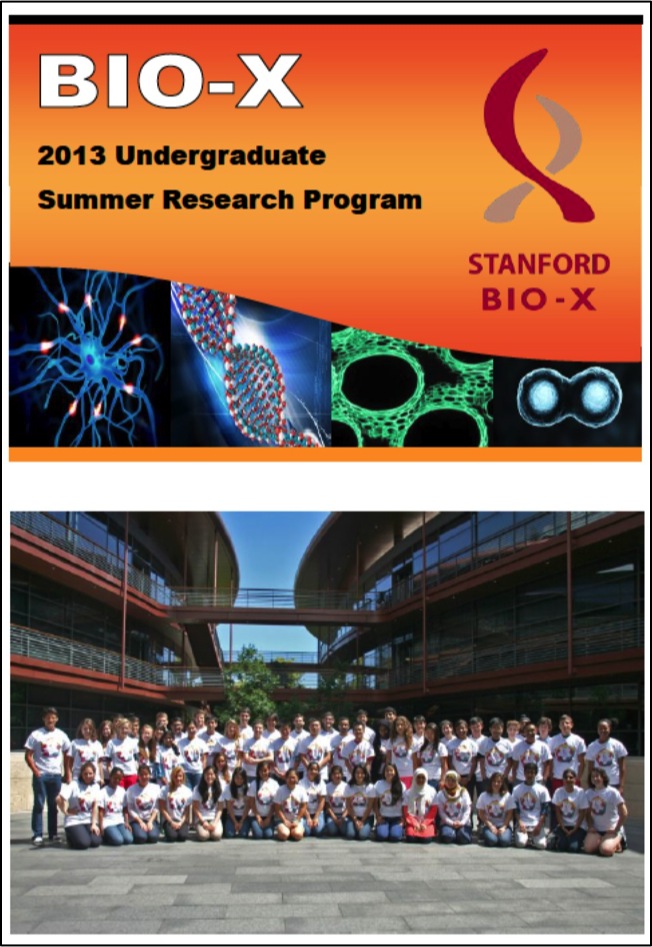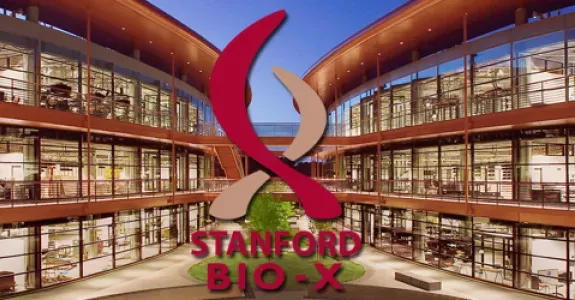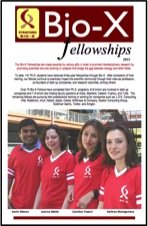
Welcome to the biweekly electronic newsletter from Stanford Bio-X for members of the Bio-X Corporate Forum. Please contact Dr. Hanwei Li, the Bio-X Corporate Forum Liaison if you would like to be added or removed from this distribution list, or if you have any questions about Stanford Bio-X or Stanford University.
Highlights
** On October 9, 2013, Bio-X celebrated the 10th Anniversary of the James H. Clark Center, the hub of Bio-X. Check out CLARK CENTER @ 10X on the SPLASH PAGE as well as the Bio-X Timeline over the last 15 years!!
** Check out the article by Stanford President John Hennessy in the Nov/Dec 2013 issue of the Stanford Magazine on Bio-X and the Clark Center, "A Cauldron of Innovation".
Seed Grants
**UPDATE: Bio-X has closed the 7th RFP for its IIP Seed Grants, and review of the 141 Letters of Intent is underway!
 SEED GRANTS FOR SUCCESS - Stanford Bio-X Interdisciplinary Initiatives Program (IIP)
SEED GRANTS FOR SUCCESS - Stanford Bio-X Interdisciplinary Initiatives Program (IIP)
The Bio-X Interdisciplinary Initiatives Program represents a key Stanford Initiative to address challenges in human health. The IIP awards approximately $3 million every other year in the form of two-year grants averaging about $150,000 each. From its inception in 2000 through the fifth round in 2010, the program has provided critical early-stage funding to 114 different interdisciplinary projects, involving collaborations from over 300 faculty members, and creating over 450 teams from five different Stanford schools. From just the first 5 rounds, the IIP awards have resulted in a 10-fold-plus return on investment, as well as hundreds of publications, dozens of patents filed, and most importantly, the acceleration of scientific discovery and innovation.
In 2012, Stanford Bio-X selected 23 new seed grant projects as the winners of the 6th round. Please go here to view the list of awardees, along with the titles of their projects and the abstracts of the research. Competition was intense as the awardees were chosen from 118 Letters of Intent (LOIs). Selection criteria included innovation, high-reward, and interdisciplinary collaboration. (To view the 114 other IIP projects that have been funded from the first 5 rounds, please click here.) In addition, SANOFI has also funded 4 new Bio-X IIP Seed Grant projects from round 6!
We are cultivating and are highly successful in building meaningful collaborations with numerous corporate colleagues. New collaborations through our seed grant projects are highly encouraged. To learn about how to get involved, please contact Dr. Hanwei Li or Dr. Heideh Fattaey.
IIP Seed Grants-Related Events
** On Monday, March 3, 2014, Bio-X had a Poster Session, featuring 105 different posters from research by all scientists within the Stanford Bio-X community. Over 250 people attended the session, which allowed for an excellent venue to discuss science and research with colleagues from both academia and industry.
** On Monday, August 26, 2013, Bio-X had its second annual IIP Symposium of the year at the Clark Center, which highlights projects that exemplify the Stanford Bio-X mission of crossing boundaries to bring about interdisciplinary research and solutions in the field of life bioscience. The symposium was a huge success with over 300 people attending this event, which included 8 oral presentations and 136 poster presentations. Recorded talks from the symposium will be uploaded soon. If you'd like to view the talks for previous symposia through the years, please click here.
Fellowships
**UPDATE: Bio-X has closed the RFP for its 11th annual Bio-X Graduate Student Fellowships, and received 100+ submissions. We will be announcing the new awardees this June 26th at the annual Fellows' Symposium.
Every year, graduate students and postdoctoral scholars of Bio-X affiliated faculty are highly encouraged to apply for the Bio-X Fellowships, which are awarded to research projects that are interdisciplinary and utilize the technologies of different fields to solve different biological questions. Students are encouraged to work collaboratively with professors of different departments, thus creating cross-disciplinary relationships among the different Stanford schools. Our fellows have conducted exciting research, resulting in publications in high-impact journals and have been offered excellent positions in industry and academia. To date, Stanford Bio-X has a total of 152 Fellows.
On June 26, 2013, Bio-X held its annual Bio-X Fellows Symposium, where there were four 15-minute oral presentations followed by one-minute spiels from current fellows. The 25 newest fellows selected this year were also announced, and about 100 attendees came to the symposium. Please click on the "Bio-X Fellows Symposium" link above for the agenda and titles of the talks, and on the icon of the brochure above for the updated and latest Bio-X Fellowships brochure.
To view the numerous projects that have been awarded over the years, please click here.
**UPDATE: Bio-X has closed the RFP for its 9th annual Bio-X USRP, and received 154 applications. The program will be starting end of this month with our new awardees.
 BIO-X UNDERGRADUATE SUMMER RESEARCH PROGRAM
BIO-X UNDERGRADUATE SUMMER RESEARCH PROGRAM
The Bio-X Undergraduate Summer Research Program supports undergraduate research training through an award designed to support interdisciplinary undergraduate summer research projects. The program is an invaluable opportunity for students to conduct hands-on research, learn how to carry out experiments in the laboratory, and develop the skills to read and analyze scientific literature.
This program is eligible to Stanford students who want to work in the labs of Bio-X affiliated faculty. To date, 241 students have been awarded the opportunity to participate in the Bio-X Undergraduate Summer Research Program. This summer is Stanford Bio-X's 8th round of USRP.
Participating undergraduates are also required to present poster presentations on the research that they've conducted during the program. Please click here for title lists of past posters that our undergraduates have presented.
Many fruitful collaborations and relationships have been established with industry through fellowships. Please contact Dr. Hanwei Li or Dr. Heideh Fattaey if you'd like to learn more about how to get involved with these fellowship programs.
News
 Solving big questions requires big computation
Solving big questions requires big computation
A common thread among research efforts across Stanford’s many disciplines is the growing use of sophisticated algorithms, run by brute computing power, to solve big questions. In Earth sciences, computer models of climate change or carbon sequestration help drive policy decisions, and in medicine computation is helping unravel the complex relationship between our DNA and disease risk. Even in the social sciences, computation is being used to identify relationships between social networks and behaviors, work that could influence educational programs. “There’s really very little research that isn’t dependent on computing,” says Ann Arvin, vice provost and dean of research. Arvin helped support the recently opened Stanford Research Computing Center (SRCC) located at SLAC National Accelerator Laboratory, which expands the available research computing space at Stanford. The building’s green technology also reduces the energy used to cool the servers, lowering the environmental costs of carrying out research. “Everyone we’re hiring is computational, and not at a trivial level,” says Stanford Provost John Etchemendy, who provided an initial set of servers at the facility. “It is time that we have this facility to support those faculty.” Here are just a few examples of how Stanford faculty are putting computers to work to crack the mysteries of our origins, our planet and ourselves.
 Stanford engineer invents safe way to transfer energy to medical chips in the body
Stanford engineer invents safe way to transfer energy to medical chips in the body
Bio-X Affiliated Faculty Ada Poon
A Stanford electrical engineer has invented a way to wirelessly transfer power deep inside the body, and then use this power to run tiny electronic medical gadgets such as pacemakers, nerve stimulators or new sensors and devices yet to be developed. The discoveries reported May 19 in the Proceedings of the National Academy of Sciences culminate years of efforts by Ada Poon, assistant professor of electrical engineering, to eliminate the bulky batteries and clumsy recharging systems that prevent medical devices from being more widely used. The technology could provide a path toward a new type of medicine that allows physicians to treat diseases with electronics rather than drugs. "We need to make these devices as small as possible to more easily implant them deep in the body and create new ways to treat illness and alleviate pain," said Poon. Poon's team built an electronic device smaller than a grain of rice that acts as a pacemaker. It can be powered or recharged wirelessly by holding a power source about the size of a credit card above the device, outside the body.
Stanford, MIT scientists find new way to harness waste heat
Bio-X Affiliated Faculty Yi Cui
Vast amounts of excess heat are generated by industrial processes and by electric power plants. Researchers around the world have spent decades seeking ways to harness some of this wasted energy. Most such efforts have focused on thermoelectric devices – solid-state materials that can produce electricity from a temperature gradient – but the efficiency of such devices is limited by the availability of materials. Now researchers at Stanford University and the Massachusetts Institute of Technology have found a new alternative for low-temperature waste-heat conversion into electricity – that is, in cases where temperature differences are less than 100 degrees Celsius. The new approach is described in a study, published in the May 21 issue of the journal Nature Communications, by Seok Woo Lee and Yi Cui at Stanford and Yuan Yang and Gang Chen at MIT. "Virtually all power plants and manufacturing processes, like steelmaking and refining, release tremendous amounts of low-grade heat to ambient temperatures," said Cui, an associate professor of materials science and engineering. "Our new battery technology is designed to take advantage of this temperature gradient at the industrial scale."
Stanford researchers discover immune system's rules of engagement
Bio-X Affiliated Faculty K. Chris Garcia
A study led by researchers at Stanford's School of Medicine reveals how T cells, the immune system's foot soldiers, respond to an enormous number of potential health threats. X-ray studies at the Department of Energy's SLAC National Accelerator Laboratory, combined with Stanford biological studies and computational analysis, revealed remarkable similarities in the structure of binding sites, which allow a given T cell to recognize many different invaders that provoke an immune response. The research demonstrates a faster, more reliable way to identify large numbers of antigens, the targets of the immune response, which could speed the discovery of disease treatments. It also may lead to a better understanding of what T cells recognize when fighting cancers and why they are triggered to attack healthy cells in autoimmune diseases such as diabetes and multiple sclerosis. "Until now, it often has been a real mystery which antigens T cells are recognizing; there are whole classes of disease where we don't have this information," said Michael Birnbaum, a graduate student who led the research at the School of Medicine in the laboratory of K. Christopher Garcia, the study's senior author and a professor of molecular and cellular physiology and of structural biology. "Now it's far more feasible to take a T cell that is important in a disease or autoimmune disorder and figure out what antigens it will respond to," Birnbaum said.
 On alert: Study identifies cell-cycle phase that primes stem cells for action
On alert: Study identifies cell-cycle phase that primes stem cells for action
Bio-X Affiliated Faculty Tom Rando
Resting, adult stem cells of many types of tissues enter a reversible “alert” phase in response to a distant injury, according to a study in mice by researchers at the Stanford University School of Medicine. The study describes for the first time a new phase in the resting portion of the cell cycle. It also explains how stem cells prime themselves to rapidly respond to tissue damage without prematurely committing to energetically expensive (and possibly unnecessary) cell division. These alert cells are distinct from fully resting or fully activated stem cells, and they divide and repair subsequent tissue damage much more quickly than do fully resting stem cells. The findings imply that nearly any type of injury may put stem cells throughout the body on notice for possible future regenerative needs. “These alert stem cells changed markedly in response to a distant muscle injury,” said Thomas Rando, MD, PhD, professor of neurobiology and neurological sciences. “They are partially awake and are poised to respond to additional challenges and make new tissue as needed. This is a systemic, or whole-body, response to injury that has never been seen before.” The researchers suggest the alert phase represents a novel form of cellular memory similar to that displayed by the immune system, which relies upon prior experiences to drive future responses.Rando, who also directs Stanford’s Glenn Laboratories for the Biology of Aging, is the senior author of the study, published online May 25 in Nature. Postdoctoral scholar Joseph Rodgers, PhD, is the lead author.
 Coaxing iPS cells to become more specialized prior to transplantation cuts rejection risk, study shows
Coaxing iPS cells to become more specialized prior to transplantation cuts rejection risk, study shows
Bio-X Affiliated Faculty Joseph Wu
For many scientists, the clinical promise of stem cells has been dampened by very real concerns that the immune system will reject the transplanted cells before they could render any long-term benefit. Previous research in mice has suggested that even stem cells produced from the subject’s own tissue, called iPS cells, can trigger an immune attack. Now researchers at the Stanford University School of Medicine have found that coaxing iPS cells in the laboratory to become more-specialized progeny cells (a cellular process called differentiation) before transplantation into mice allows them to be tolerated by the body’s immune system. “Induced pluripotent stem cells have tremendous potential as a source for personalized cellular therapeutics for organ repair,” said Joseph Wu, MD, PhD, director of the Stanford Cardiovascular Institute. “This study shows that undifferentiated iPS cells are rejected by the immune system upon transplantation in the same recipient, but that fully differentiating these cells allows for acceptance and tolerance by the immune system without the need for immunosuppression.” The findings are described in a paper published online May 30 in Nature Communications. Wu is senior author of the paper. Postdoctoral scholars Patricia Almeida, PhD, and Nigel Kooreman, MD, and assistant professor of medicine Everett Meyer, MD, PhD, share lead authorship.
Events
| Neurosciences Institute June 5, 2014, 12 pm - 1 pm Clark Auditorium, Stanford, CA "Glia in development and maintenance of synaptic positions: lessons from C. elegans" Speaker: Daniel Colon-Ramos, PhD, Yale |
Genetics June 9, 2014, 4:30 pm - 5:30 pm LKSC Rm LK 130, Stanford, CA "Pathogenomics: Solving old (idiopathic) problems with new (metagenomic) tools" Speaker: Ami Bhatt, MD, PhD, Dana-Farber/Partners Cancer Center |
| Pathology June 12, 2014, 12 pm - 1 pm Edwards Building Rm 358, Stanford, CA "Epithelial cells as barrier and immune regulators: Therapeutic target for allergic airway disease " Speaker: Ruby Pawankar, MD, PhD, Nippon Medical School |
Cardiovascular Institute June 17, 2014, 12 pm - 1 pm Alway M106, Stanford, CA "Inflammation, immunity and hypertension. You’ve got to be kidding?" Speaker: David Harrison, MD, Betty and Jack Bailey Professor of Medicine and Pharmacology |
Resources
| Stanford University |
| Stanford Bio-X |
| Bio-X Seed Grants The Stanford Bio-X Interdisciplinary Initiatives Program (IIP) provides seed funding for high-risk, high-reward, collaborative projects across the university, and have been highly successful in fostering transformative research. |
| Office of Technology and Licensing "Techfinder" Search the OTL Technology Portal to find technologies available for licensing from Stanford. |
| Stanford Center for Professional Development - Take advantage of your FREE membership! - Take online graduate courses in engineering, leadership and management, bioscience, and more. - Register for free webinars and seminars, and gets discounts on courses. |
| Stanford Biodesign Video Tutorials on how FDA approves medical devices A series of video briefs recently produced by the Stanford Biodesign Program teaches innovators how to get a medical device approved for use in the United States. This free, online library of 60 videos provides detailed information on the Food and Drug Administration regulatory process, short case studies and advice on interacting with the FDA. |
To learn more about Stanford Bio-X or Stanford University, please contact Dr. Hanwei Li, the Bio-X Corporate Forum Liaison, at 650-725-1523 or lhanwei1@stanford.edu, or Dr. Heideh Fattaey, the Executive Director of Bio-X Operations and Programs, at 650-799-1608 or hfattaey@stanford.edu.


